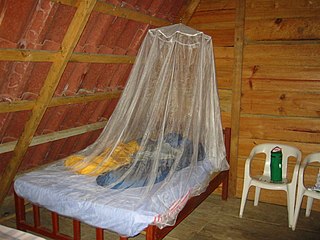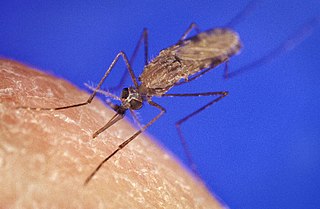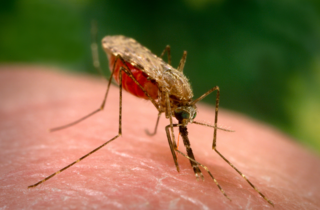
Malaria is a mosquito-borne infectious disease that affects humans and other vertebrates. Human malaria causes symptoms that typically include fever, fatigue, vomiting, and headaches. In severe cases, it can cause jaundice, seizures, coma, or death. Symptoms usually begin 10 to 15 days after being bitten by an infected Anopheles mosquito. If not properly treated, people may have recurrences of the disease months later. In those who have recently survived an infection, reinfection usually causes milder symptoms. This partial resistance disappears over months to years if the person has no continuing exposure to malaria.

Mosquitoes, the Culicidae, are a family of small flies consisting of 3,600 species. The word "mosquito" is Spanish for "little fly". Mosquitoes have a slender segmented body, one pair of wings, three pairs of long hair-like legs, and specialized, highly elongated, piercing-sucking mouthparts. All mosquitoes drink nectar from flowers; females of some species have in addition adapted to drink blood. Evolutionary biologists view mosquitoes as micropredators, small animals that parasitise larger ones by drinking their blood without immediately killing them. Medical parasitologists view mosquitoes instead as vectors of disease, carrying protozoan parasites or bacterial or viral pathogens from one host to another.

Plasmodium is a genus of unicellular eukaryotes that are obligate parasites of vertebrates and insects. The life cycles of Plasmodium species involve development in a blood-feeding insect host which then injects parasites into a vertebrate host during a blood meal. Parasites grow within a vertebrate body tissue before entering the bloodstream to infect red blood cells. The ensuing destruction of host red blood cells can result in malaria. During this infection, some parasites are picked up by a blood-feeding insect, continuing the life cycle.

Anopheles is a genus of mosquito first described by J. W. Meigen in 1818. Its members are sometimes called nail mosquitoes or marsh mosquitoes. Many are vectors of the parasite Plasmodium, which causes malaria in birds, reptiles, and mammals including humans. Anopheles gambiae is the best-known species, as it transmits one of the most dangerous human malarial parasites, Plasmodium falciparum. No other mosquito genus is a vector of human malaria.

Plasmodium falciparum is a unicellular protozoan parasite of humans, and the deadliest species of Plasmodium that causes malaria in humans. The parasite is transmitted through the bite of a female Anopheles mosquito and causes the disease's most dangerous form, falciparum malaria. It is responsible for around 50% of all malaria cases. P. falciparum is therefore regarded as the deadliest parasite in humans. It is also associated with the development of blood cancer and is classified as a Group 2A (probable) carcinogen.
A trophozoite is the activated, feeding stage in the life cycle of certain protozoa such as malaria-causing Plasmodium falciparum and those of the Giardia group. The complementary form of the trophozoite state is the thick-walled cyst form. They are often different from the cyst stage, which is a protective, dormant form of the protozoa. Trophozoites are often found in the host's body fluids and tissues and in many cases, they are the form of the protozoan that causes disease in the host. In the protozoan, Entamoeba histolytica it invades the intestinal mucosa of its host, causing dysentery, which aid in the trophozoites traveling to the liver and leading to the production of hepatic abscesses.

A mosquito net is a type of meshed curtain that is circumferentially draped over a bed or a sleeping area, to offer the sleeper barrier protection against bites and stings from mosquitos, flies, and other pest insects, and thus against the diseases they may carry. Examples of such preventable insect-borne diseases include malaria, dengue fever, yellow fever, zika virus, Chagas disease and various forms of encephalitis, including the West Nile virus.

Fotis Constantine Kafatos was a Greek biologist. Between 2007-2010 he was the founding president of the European Research Council (ERC). He chaired the ERC Scientific Council from 2006-2010. Thereafter, he was appointed Honorary President of the ERC.

Plasmodium berghei is a single-celled parasite causing rodent malaria. It is in the Plasmodium subgenus Vinckeia.

The Anopheles gambiae complex consists of at least seven morphologically indistinguishable species of mosquitoes in the genus Anopheles. The complex was recognised in the 1960s and includes the most important vectors of malaria in sub-Saharan Africa, particularly of the most dangerous malaria parasite, Plasmodium falciparum. It is one of the most efficient malaria vectors known. The An. gambiae mosquito additionally transmits Wuchereria bancrofti which causes lymphatic filariasis, a symptom of which is elephantiasis.

Mosquito-borne diseases or mosquito-borne illnesses are diseases caused by bacteria, viruses or parasites transmitted by mosquitoes. Nearly 700 million people get a mosquito-borne illness each year, resulting in over 725,000 deaths.

A genetically modified (GM) insect is an insect that has been genetically modified, either through mutagenesis, or more precise processes of transgenesis, or cisgenesis. Motivations for using GM insects include biological research purposes and genetic pest management. Genetic pest management capitalizes on recent advances in biotechnology and the growing repertoire of sequenced genomes in order to control pest populations, including insects. Insect genomes can be found in genetic databases such as NCBI, and databases more specific to insects such as FlyBase, VectorBase, and BeetleBase. There is an ongoing initiative started in 2011 to sequence the genomes of 5,000 insects and other arthropods called the i5k. Some Lepidoptera have been genetically modified in nature by the wasp bracovirus.

Anopheles stephensi is a primary mosquito vector of malaria in urban India and is included in the same subgenus as Anopheles gambiae, the primary malaria vector in Africa. A. gambiae consists of a complex of morphologically identical species of mosquitoes, along with all other major malaria vectors; however, A. stephensi has not yet been included in any of these complexes. Nevertheless, two races of A. stephensi exist based on differences in egg dimensions and the number of ridges on the eggs; A. s. stephensisensu stricto, the type form, is a competent malaria vector that takes place in urban areas, and A. s. mysorensis, the variety form, exists in rural areas and exhibits considerable zoophilic behaviour, making it a poor malaria vector. However, A. s. mysorensis is a detrimental vector in Iran. An intermediate form also exists in rural communities and peri-urban areas, though its vector status is unknown. About 12% of malaria cases in India are due to A. stephensi.
Thioester containing protein 1, often called TEP1 is a key component of the arthropod innate immune system. TEP1 was first identified as a key immunity gene in 2001 through functional studies on Anopheles gambiae mosquitoes.

Anopheles sinensis is a species of mosquito that transmits malaria as well as lymphatic filariasis. It is regarded as the most important vector of these human parasitic diseases in Southeast Asia. It is the primary vector of vivax malaria in many regions. In China it also transmits the filalarial parasite, and arthropod roundworm. In Japan it is also a vector of a roundworm Setaria digitata in sheep and goats.

Thorselliaceae is a family of bacteria belonging to the class Gammaproteobacteria and it was first described in February 2015. It is not assigned to an order. The family consists of four species in two genera. The bacteria are Gram-negative and rod shaped, approximately 1 μm wide and 2 μm long. They are facultative anaerobes and motile. Thorselliaceae bacteria have been found around the world associated with vector mosquitoes, mainly with vectors of malaria.

Andrea Crisanti is an Italian full professor of microbiology at the University of Padua and politician. He previously was professor of Molecular Parasitology at Imperial College London. He is best known for the development of genetically manipulated mosquitoes with the objective to interfere with either their reproductive rate or the capability to transmit diseases such as malaria.
Anopheles nili is a species of mosquito in the Culicidae family. It comprises the following elements: An. carnevalei, An. nili, An. ovengensis and An. somalicus. The scientific name of this species was first published in 1904 by Theobald. It is the main mosquito species found in the south Cameroon forest zone which bites humans. It is known as a problematic carrier of malaria, although newly discovered, closely related species in the same genus have also been found to interact with A. nili as a disease vector. In that, they both have similar feeding habits on local targets in the Cameroon region.

Anopheles arabiensis is a zoophilic species of mosquito and a vector of disease endemic to Africa.
Abdoulaye Diabaté is an African Parasitologist, Professor and Head of the Medical Entomology and Parasitology Department at the Health Sciences Research Institute. He was awarded the 2023 Falling Walls Science Prize for Science and Innovation Management.
















